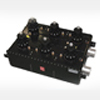
Broadcast sector is a very wide and dynamic industry. Not only in terms of delivering or broadcasting information through different media, but also the technical infrastructure behind the screen plays a very vital role for its successful deliverance. Filters and Combiners are the components that connect the technical infrastructure at studios, stations and even at domestic broadcast equipment like video, audio, data transformation service systems, etc.
In the recent years a lot of innovations evolved and came in availability to the industry. One of the major technical advancements in combiner and filters for broadcast industry is through the entrance of the modules. The combiner units forms the backbone of media set network. Shively Labs, a broadcast equipment designing and manufacturing company came up with balanced combiner modules that allow any number of stations to be combined into a common antenna. Systems have been designed to handle up to 21 analog stations, along with their digital counterparts. The frequency spacings as close as 0.8 MHz are routine, even on large systems and the design allows stations to be added in any frequency order without the need to reconfigure the existing combiner chain – making them ideal for sites where future expansion is planned.
Many industry events like NABSHOW are venues for companies to showcase and introduce their new products. Filters and combiners presented at NABSHOW 2012 attracted attention of the market. Radio Frequency Systems has added technology innovations and new models to its line of filters and combiners with the introduction of PeakPower+ at the event.
A lot of scope is recognized by the manufacturers for the combiners and filters. The evidence is the evolution of Combining Units, which is a replacement for lot of technical material surrounded by the broadcast equipment.
The PeakPower+ line of filters and combiners is specifically aimed at safely sustaining the very high peak power of digital television, and represents a major breakthrough in coaxial filter technology.
By removing the peak power handling limitations imposed on digital transmitter filter & combiner systems, PeakPower+ TM allows broadcast operators to safely run their systems without fear of interruptions, and boost revenues by adding digital channels and services to their existing infrastructure, without having to upgrade to waveguide technology.
DSL line combiners are from Pace plc that subscribers get "splittered" service, where DSL and telephone service are terminated into the home on separate lines. This has 2 types. Line Inline Filter with Giveback Jack and Line Inline Filter with Giveback Jack are the types available in this product.
Bandpass filters and Transmitting Combiners from Com-Tech Italia SpA are 4 types each.
The Bandpass Filter is a terrestrial broadcasting of the television signal for Analog TV (ATV) and Digital TV: DVB-T, DVB-H, ATSC (DTV), needs a high degree of linearity by the output amplifiers. So, the more an amplifier is pushed in power, the more it generates products from distortion within and outside the transmitted channel.
The Com-Tech Transmitting Combiners and Multiplexers are devices that can able to sum various inputs with different frequencies on a single output and this is a suitable application in television broadcasting as transmission of various channels take place on a single broadband antenna.
AISG/3GPP- compatible DC connections of Spinner Atlanta’s is a model that allows the transfer of control signals and power supply to antenna pre-amplifiers. The core advantage is that all the frequency combiners are suitable for indoor and outdoor installation.
While, in broadcast applications multi-channel combiners are used to combine the signals of two or several channels on to one antenna. Depending on the channel spacing Spinner has solutions for combining.
The broadcast industry market scope and demand is there at every corner of the globe. The quality and robustness of its products and services from the industry players would build up an enviable reputation for the manufacturers.